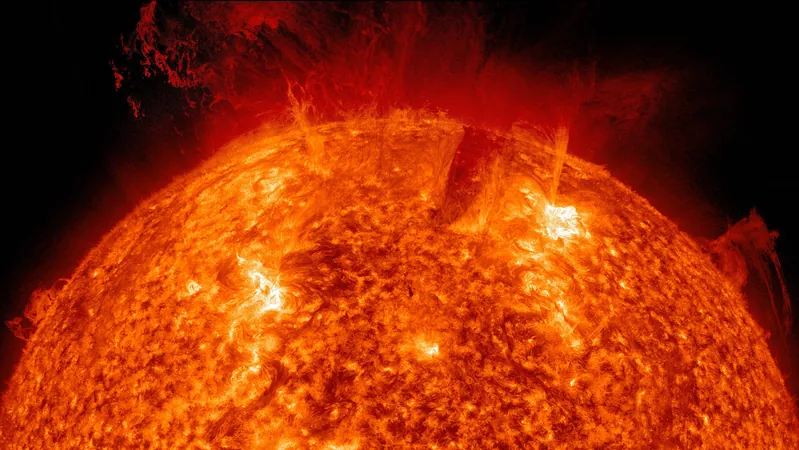
Are We Prepared for Catastrophic Space Weather? Here's What You Need to Know
2025-05-20
Author: Ming
Picture this: a massive storm is barreling towards Earth, but you're left in the dark about its strength until minutes before its arrival. This is the perplexing reality scientists face when trying to forecast solar storms.
Though we've made remarkable strides in understanding space weather—tracking solar storm eruptions, gauging their speeds, and even estimating their arrival with up to a day's notice—there's one critical factor that eludes us until the last moment: the magnetic field’s orientation, or Bz component, of the incoming storm.
The Role of Bz in Solar Storms
When a coronal mass ejection (CME) erupts from the sun, it carries plasma and magnetic fields along for the ride. Whether this magnetic field points north or south significantly impacts its interaction with Earth's own magnetic field. A southward Bz aligns quickly with Earth's field, flooding our atmosphere with energy, leading to spectacular auroras—but it can also wreak havoc, disrupting satellites and power grids. Conversely, a northward Bz passes by with barely a whisper.
Understanding the Bz component is crucial for effectively preparing for a solar storm. Valentín Martínez Pillet, a solar physicist, emphasizes the need for immediate predictions of Bz once a CME erupts, rather than waiting for data that trickles in from L1, where we often get just a one or two-hour warning.
Why Are We Lacking the Data?
Martínez Pillet forecasts that it may take around 50 years for space weather predictions to reach a level of reliability comparable to those for Earth weather. He points out that while progress is being made, we are hindered by a lack of diverse observations from multiple perspectives of the sun. Right now, our most significant data comes primarily from spacecraft near Lagrange Point 1—about a million miles from Earth—which offers limited notice before storms strike.
To enhance our forecasting capabilities, we need additional satellites stationed at various Lagrange points. Although launching these can be expensive, Martínez Pillet is optimistic about future advancements.
Time is of the Essence
So what's holding us back from building a comprehensive system right now? The stark reality is cost and complexity. Space weather forecasting isn't currently allocated the same resources as traditional weather forecasting, even as our dependency on technology soars. The necessity for robust space weather infrastructure is apparent, yet implementing these improvements could take decades—with no guarantees of consistent funding.
Waiting 50 years might be perilous. Rare but destructive solar storms, similar to the notable Carrington Event of 1859, could inflict trillions of dollars in damage today, disabling satellites and crippling power grids.
Learning from the Past: A Narrow Escape
Consider the near miss from a powerful CME in July 2012. If that massive eruption had occurred just a week earlier, it could have hit Earth and left us reeling for years. Dan Baker from the University of Colorado cautioned that such an event would have devastating technological repercussions.
Current Monitoring and Future Missions
As our reliance on technology increases, vulnerability to solar storms grows. Martínez Pillet points out the irony: while the sun remains unchanged, our dependence on technology is escalating.
To keep tabs on the sun, we currently use several essential tools. The Global Oscillation Network Group (GONG) operates a network of six telescopes giving near-continuous coverage of solar activity, aiding in predictions of solar eruptions.
Another key player is the Deep Space Climate Observatory (DSCOVR), positioned at L1. This spacecraft warns us about geomagnetic storms with mere minutes of lead time, critical for satellite and power grid operations.
Looking to the Future
Future missions like the European Space Agency's Vigil, set to launch in 2031, promise to change the game. By observing the sun from Lagrange Point 5, Vigil will give scientists a side view of solar eruptions, helping to predict essential factors like the Bz component long before they reach Earth.
Martínez Pillet is eager to see how this data will improve predictive models, offering potentially crucial insights days in advance. 'It's better than nothing,' he concludes.


 Brasil (PT)
Brasil (PT)
 Canada (EN)
Canada (EN)
 Chile (ES)
Chile (ES)
 Česko (CS)
Česko (CS)
 대한민국 (KO)
대한민국 (KO)
 España (ES)
España (ES)
 France (FR)
France (FR)
 Hong Kong (EN)
Hong Kong (EN)
 Italia (IT)
Italia (IT)
 日本 (JA)
日本 (JA)
 Magyarország (HU)
Magyarország (HU)
 Norge (NO)
Norge (NO)
 Polska (PL)
Polska (PL)
 Schweiz (DE)
Schweiz (DE)
 Singapore (EN)
Singapore (EN)
 Sverige (SV)
Sverige (SV)
 Suomi (FI)
Suomi (FI)
 Türkiye (TR)
Türkiye (TR)
 الإمارات العربية المتحدة (AR)
الإمارات العربية المتحدة (AR)